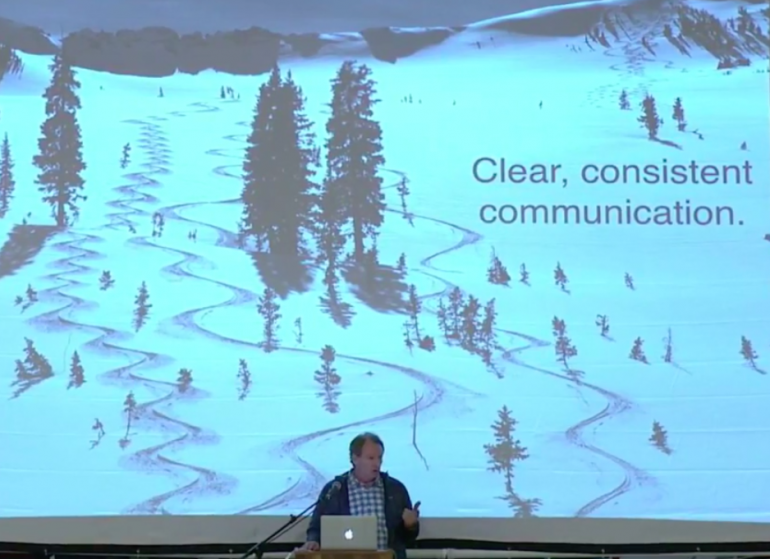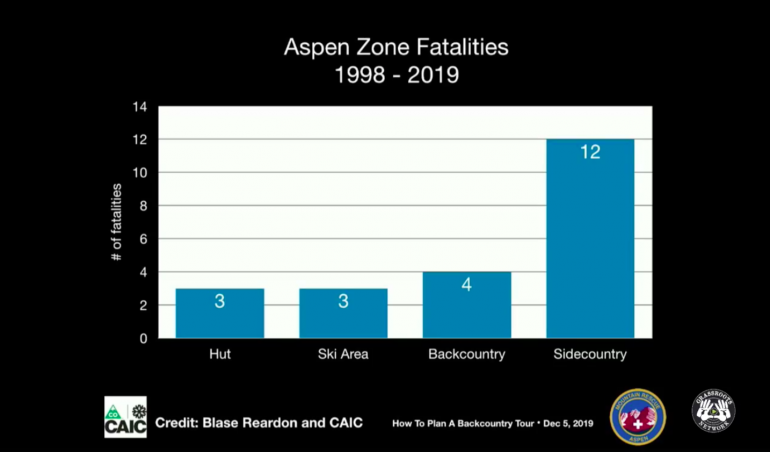
Michael Kennedy closed the event with the ever important topic of human dimensions in backcountry travel.
Navigation, snowpack, sidecountry fatalities and the human dimensions that tie it all together
Roughly 100 Roaring Fork Valley locals filled the cavernous garage of Mountain Rescue Aspen HQ last night. The event du jour was a talk on how to plan a backcountry tour. On the docket were topics like navigation, emergency response and gear, sidecountry dangers, local snowpack assessment and human factor in decision making.
With small plates of assorted cheeses, caprese salad skeweres, and mini desert cakes in hand, the audience, ranging from Aspen OGs to valley and backcountry newcomers and even a few tykes and teens, listened intently as each speaker dished out the backcountry know-how. Greg Schaffran of Mountain Rescue offered CalTopo navigation tips. Debbie Kelly demonstrated a few of her favorite pieces of emergency gear (large black trash bag, first aid and repair kits, a big down jacket, extra food, and rescue sleds). Brian Lazar of CIAC offered insights into Colorado’s snowpack so far (seven partial burials this season and NNE slopes essentially persistent slab mine fields).
Since we’ve talked at length about many of those topics here on WildSnow, I’m going to jump to the two major points that stuck out to me:
“There is no sidecountry”
Michael Kennedy said this in his portion of the presentation on human dimensions (see below), but Shaffran illlustrated it in his talk when he pulled up the following graph of avalanche fatalities in the Aspen area from 1998-2019:

Greg Shaffran offered eye-opening stats on fatalities in the Aspen area. Image courtesy of MRA livestream and CAIC.
Yep, you read it correctly. There were more fatalities in sidecountry off the Aspen Ski areas than all of the other areas combined.
“A lot of people think that sidecountry or slack country is safer,” he said, “but the statistics say otherwise.”
Rich Burkley of Aspen Ski Co expanded on this in his discussion of resort uphilling and side country concerns. “We don’t call it ‘sidecountry’,” he said, and neither does the Forest Service or the Sheriff’s Office. Once ski area users pass through boundary gates, they are fully in the backcountry and fully on their own.
The perception of sidecountry being safer than backcountry dovetails into the other point that stuck out to me:
Never overlook human factors
“What’s in your pack is important,” Michael Kennedy said at the start of his talk on human factors, “but so is what’s in your head.” He cited knowledge, experience, attitude and rituals as cornerstones to approaching backcountry travel in Colorado in winter. Kennedy also called upon the Park’s Canada Avalanche Terrain Exposure Scale and the ALPTRUTH system for decision making as useful and important tools to use when in the backcountry.
Of course, a conversation about human factors would be incomplete without mention of heuristics in avalanche terrain, a topic well covered on WildSnow and always worth revisiting. Of the six common heuristics, I could easily see the following contributing to side country fatalities: familiarity (with that particular slope or the ski area), social proof (others go out of these gates all the time and they’re fine), scarcity (this on-piste powder is tracked to shreds, let’s get what we came skiing for)…hmm everything is connected.
Kennedy also offered a few suggestions for rituals to ensure your group is all on the same page. Make a run list that includes “okay to plan, don’t know, NFW” (code, of course, for no f-ing way). The last one is crucial for those days when things look better than you expected and you start to salivate while eyeing up that forbidden line…
He closed by suggesting that groups take a rest and have a bite eat before making a big decision. And, that after a great day out, you ask yourself and your group members: did we get it done, or did we get away with it?
Great fodder to start another season of safe backcountry touring in Colorado. If you want to watch the whole talk, check out the livecast on Mountain Rescue Aspen’s Facebook page.
Sidenote: this was one of two backcountry planning events to occur within a two-mile radius last night. Ben Latow of Cal-Topo simultaneously hosted a Cal-Topo talk at CCBC’s Aspen shop. Cheers to education and awareness in backcountry communities!
Manasseh Franklin is a writer, editor and big fan of walking uphill. She has an MFA in creative nonfiction and environment and natural resources from the University of Wyoming and especially enjoys writing about glaciers. Find her other work in Alpinist, Adventure Journal, Rock and Ice, Aspen Sojourner, AFAR, Trail Runner and Western Confluence.
